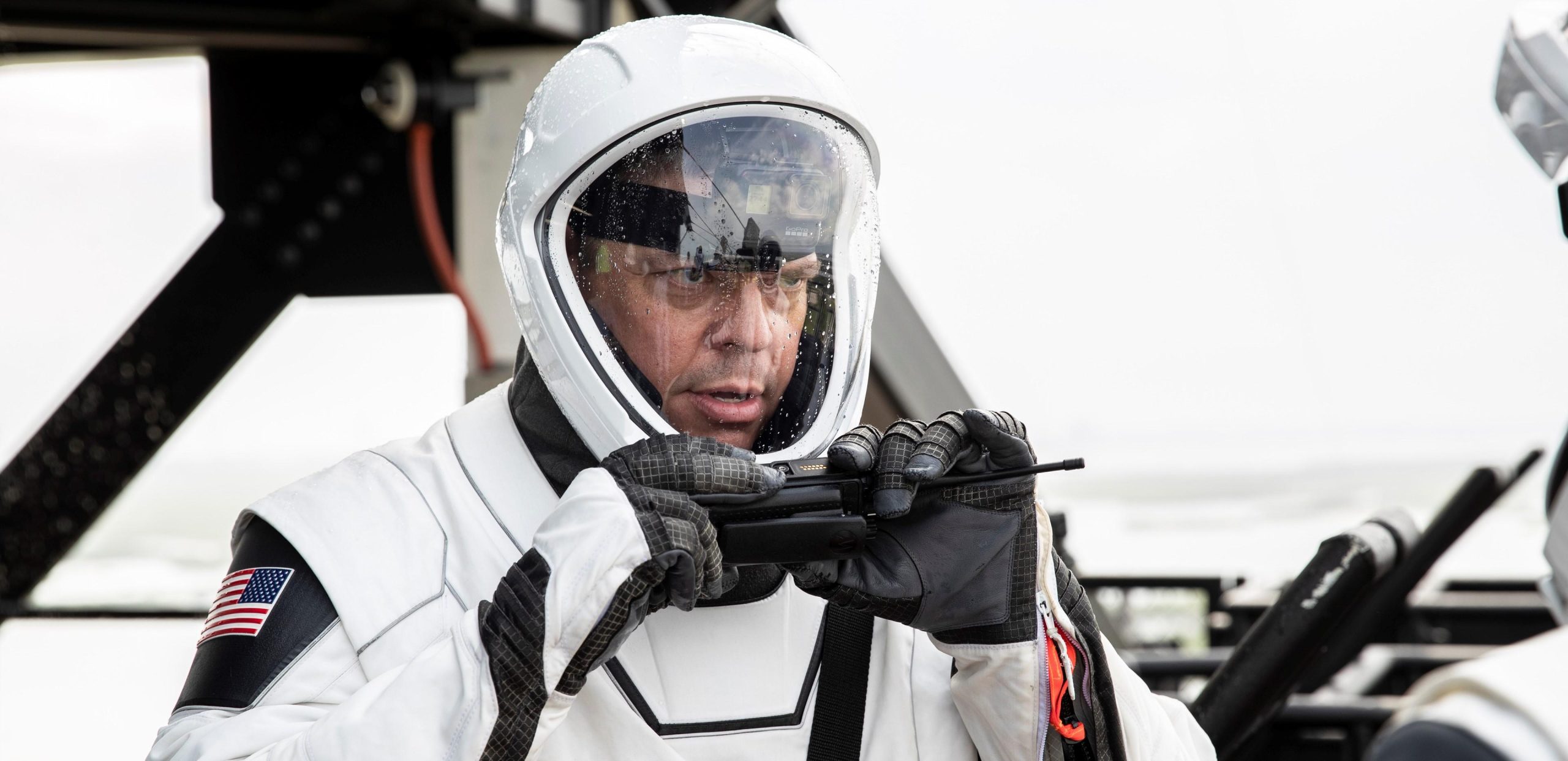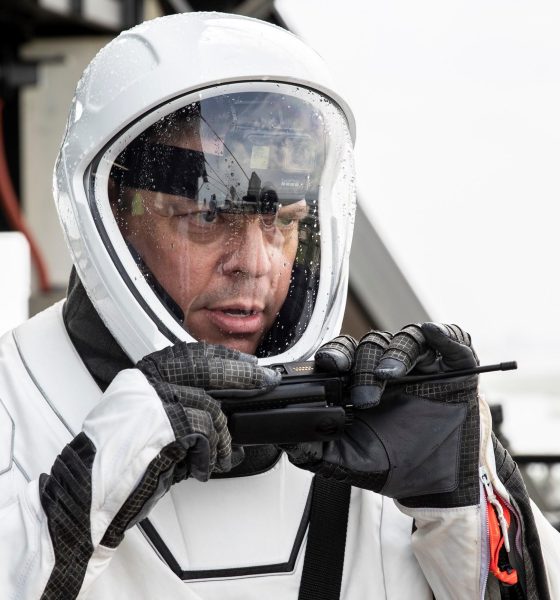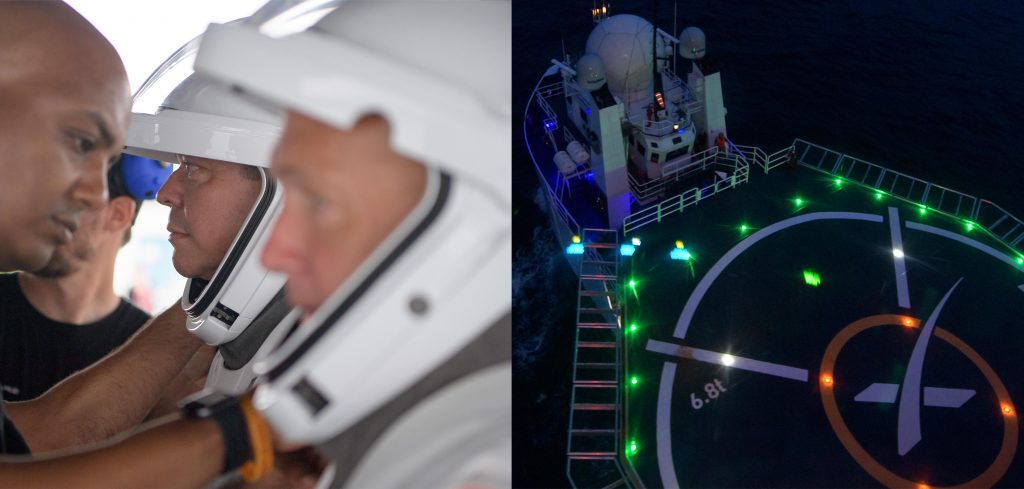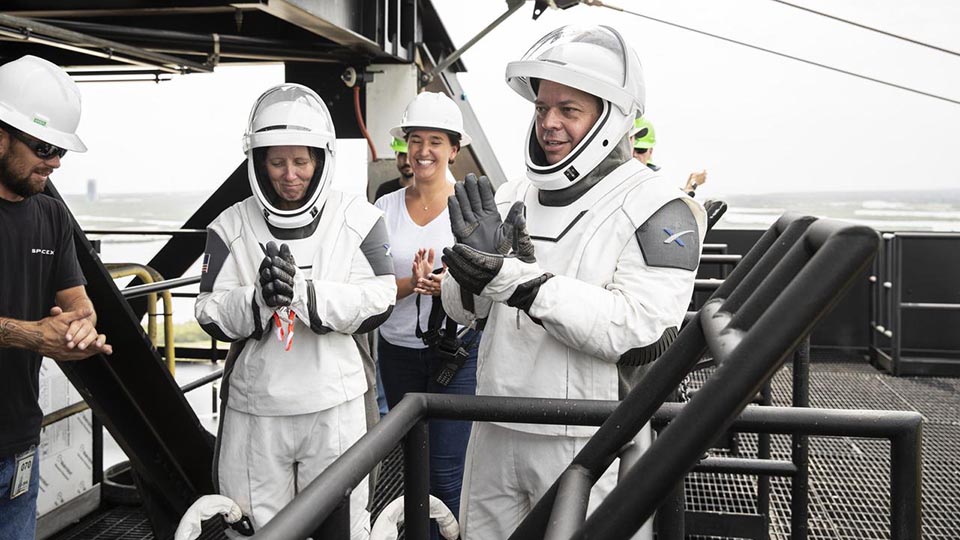

News
SpaceX, NASA test escape zipline ahead of Crew Dragon’s astronaut launch debut
As part of continued preparations ahead of SpaceX’s Demonstration-2 mission (DM-2) that will debut Crew Dragon’s ability to support astronaut flight, SpaceX and NASA have successfully tested crew emergency egress (escape) systems at SpaceX’s primary crew launch facilities located at Launch Complex 39-A (LC-39A) at Kennedy Space Center in Florida. The successful verification tests have proven that SpaceX is ready to support crewed launches and preserve human life with effective escape methods, including a zipline mounted basket system that will whisk astronauts away from Crew Dragon and Falcon 9 in the event of a launch pad anomaly.
The formal launch pad escape verification test comes just a month after SpaceX and NASA CCP teams practiced astronaut recovery rehearsals – including emergency astronaut evacuation – from a high-fidelity Crew Dragon mockup capsule aboard the recovery Vessel GO Searcher.

Multiple teams from NASA and SpaceX including personnel from the Astronaut Office at NASA’s Johnson Space Center in Houston, NASA Flight Surgeons, SpaceX systems engineers, Kennedy Aero Medical, and Commercial Crew Program Safety worked together to successfully complete two full-dress rehearsals of different escape methods.
In a Commercial Crew Program (CCP) blog post, NASA CCP launch operations integrator Steve Payne stated that “this demonstration allowed all the various teams responsible for ground operations, system design, ground safety and emergency management to observe and verify the system is ready for operational use.”
The launch pad escape methods practiced at LC-39A simulated evacuation plans that would usher flight and pad crew members to safety should any sort of life-threatening anomaly occur during launch proceedings. Two different versions of escape methods were practiced – a quick emergency evacuation utilizing the zipline system and a less life-threatening situation using an elevator.

Both escape plans require that crew members are able to evacuate the crew access arm and crew-loading level of the Fixed Service Structure (FSS) at LC-39A, located some 265ft in the air. During SpaceX renovations of LC-39A the crew loading platform was moved roughly half a level higher to accommodate the Crew Dragon capsule’s position atop a Falcon 9 booster, as the Crew Dragon stack is far different from and significantly taller than the Space Shuttles that previously flew from LC 39-A.
One exit method demonstrated how both flight and pad crew members could exit the launch pad under non-emergency circumstances. NASA astronauts Bob Behnken and Shannon Walker participated in the exercises and began the first rehearsal at the end of the crew access arm (CAA) – known as a white room – and took an elevator in the FSS to the ground before being escorted to a safe location nearby.

The second rehearsal simulated an emergency (i.e. time-sensitive) egress with active escape alarms and fire suppression systems that required the astronauts and pad crew to escape the launch tower using slide-wire mounted – essentially a serious zipline – basket transport system. This method has been around for decades and during the SpaceX LC-39A renovations some much-needed upgrades were implemented, including a new braking system to control basket descent speed and modifications to allow easier exit from the baskets.

In the blog post, Behnken expressed excitement about the completion of the verification tests, as they bring him and his colleagues one step closer to launching to orbit aboard SpaceX’s Crew Dragon spacecraft. “It’s exciting to have this verification test behind us on our way to the SpaceX Demo-2 mission. Each time today when we headed down the crew access arm, I couldn’t help but think about what it will be like to strap into Dragon on launch day.”
Behnken’s words reflect the anticipation and excitement that is shared by all as we await the historic and triumphant return of human spaceflight from US soil when SpaceX’s Crew Dragon capsule carries astronauts to the International Space Station for the first time. SpaceX CEO, Elon Musk, recently stated that the Crew Dragon capsule (C204) and trunk that will support DM-2 and (hopefully) push SpaceX into a new era of human spaceflight is set to arrive in Florida as early as November 2019. The Falcon 9 booster (B1058) has already completed static fire testing in Texas and is likely already in Florida or set to arrive imminently.
If all goes as planned during Crew Dragon’s upcoming in-flight abort (IFA) test and NASA is able to efficiently complete its myriad of reviews and paperwork, SpaceX should be ready to launch its first astronauts into orbit early next year.
Check out Teslarati’s newsletters for prompt updates, on-the-ground perspectives, and unique glimpses of SpaceX’s rocket launch and recovery processes.

News
Tesla starts showing how FSD will change lives in Europe
Local officials tested the system on narrow country roads and were impressed by FSD’s smooth, human-like driving, with some calling the service a game-changer for everyday life in areas that are far from urban centers.

Tesla has launched Europe’s first public shuttle service using Full Self-Driving (Supervised) in the rural Eifelkreis Bitburg-Prüm region of Germany, demonstrating how the technology can restore independence and mobility for people who struggle with limited transport options.
Local officials tested the system on narrow country roads and were impressed by FSD’s smooth, human-like driving, with some calling the service a game-changer for everyday life in areas that are far from urban centers.
Officials see real impact on rural residents
Arzfeld Mayor Johannes Kuhl and District Administrator Andreas Kruppert personally tested the Tesla shuttle service. This allowed them to see just how well FSD navigated winding lanes and rural roads confidently. Kruppert said, “Autonomous driving sounds like science fiction to many, but we simply see here that it works totally well in rural regions too.” Kuhl, for his part, also noted that FSD “feels like a very experienced driver.”
The pilot complements the area’s “Citizen Bus” program, which provides on-demand rides for elderly residents who can no longer drive themselves. Tesla Europe shared a video of a demonstration of the service, highlighting how FSD gives people their freedom back, even in places where public transport is not as prevalent.
What the Ministry for Economic Affairs and Transport says
Rhineland-Palatinate’s Minister Daniela Schmitt supported the project, praising the collaboration that made this “first of its kind in Europe” possible. As per the ministry, the rural rollout for the service shows FSD’s potential beyond major cities, and it delivers tangible benefits like grocery runs, doctor visits, and social connections for isolated residents.
“Reliable and flexible mobility is especially vital in rural areas. With the launch of a shuttle service using self-driving vehicles (FSD supervised) by Tesla in the Eifelkreis Bitburg-Prüm, an innovative pilot project is now getting underway that complements local community bus services. It is the first project of its kind in Europe.
“The result is a real gain for rural mobility: greater accessibility, more flexibility and tangible benefits for everyday life. A strong signal for innovation, cooperation and future-oriented mobility beyond urban centers,” the ministry wrote in a LinkedIn post.
News
Tesla China quietly posts Robotaxi-related job listing
Tesla China is currently seeking a Low Voltage Electrical Engineer to work on circuit board design for the company’s autonomous vehicles.

Tesla has posted a new job listing in Shanghai explicitly tied to its Robotaxi program, fueling speculation that the company is preparing to launch its dedicated autonomous ride-hailing service in China.
As noted in the listing, Tesla China is currently seeking a Low Voltage Electrical Engineer to work on circuit board design for the company’s autonomous vehicles.
Robotaxi-specific role
The listing, which was shared on social media platform X by industry watcher @tslaming, suggested that Tesla China is looking to fill the role urgently. The job listing itself specifically mentions that the person hired for the role will be working on the Low Voltage Hardware team, which would design the circuit boards that would serve as the nervous system of the Robotaxi.
Key tasks for the role, as indicated in the job listing, include collaboration with PCB layout, firmware, mechanical, program management, and validation teams, among other responsibilities. The role is based in Shanghai.
China Robotaxi launch
China represents a massive potential market for robotaxis, with its dense urban centers and supportive policies in select cities. Tesla has limited permission to roll out FSD in the country, though despite this, its vehicles have been hailed as among the best in the market when it comes to autonomous features. So far, at least, it appears that China supports Tesla’s FSD and Robotaxi rollout.
This was hinted at in November, when Tesla brought the Cybercab to the 8th China International Import Expo (CIIE) in Shanghai, marking the first time that the autonomous two-seater was brought to the Asia-Pacific region. The vehicle, despite not having a release date in China, received a significant amount of interest among the event’s attendees.
Elon Musk
Elon Musk and Tesla AI Director share insights after empty driver seat Robotaxi rides
The executives’ unoccupied tests hint at the rapid progress of Tesla’s unsupervised Robotaxi efforts.

Tesla CEO Elon Musk and AI Director Ashok Elluswamy celebrated Christmas Eve by sharing personal experiences with Robotaxi vehicles that had no safety monitor or occupant in the driver’s seat. Musk described the system’s “perfect driving” around Austin, while Elluswamy posted video from the back seat, calling it “an amazing experience.”
The executives’ unoccupied tests hint at the rapid progress of Tesla’s unsupervised Robotaxi efforts.
Elon and Ashok’s firsthand Robotaxi insights
Prior to Musk and the Tesla AI Director’s posts, sightings of unmanned Teslas navigating public roads were widely shared on social media. One such vehicle was spotted in Austin, Texas, which Elon Musk acknowleged by stating that “Testing is underway with no occupants in the car.”
Based on his Christmas Eve post, Musk seemed to have tested an unmanned Tesla himself. “A Tesla with no safety monitor in the car and me sitting in the passenger seat took me all around Austin on Sunday with perfect driving,” Musk wrote in his post.
Elluswamy responded with a 2-minute video showing himself in the rear of an unmanned Tesla. The video featured the vehicle’s empty front seats, as well as its smooth handling through real-world traffic. He captioned his video with the words, “It’s an amazing experience!”
Towards Unsupervised operations
During an xAI Hackathon earlier this month, Elon Musk mentioned that Tesla owed be removing Safety Monitors from its Robotaxis in Austin in just three weeks. “Unsupervised is pretty much solved at this point. So there will be Tesla Robotaxis operating in Austin with no one in them. Not even anyone in the passenger seat in about three weeks,” he said. Musk echoed similar estimates at the 2025 Annual Shareholder Meeting and the Q3 2025 earnings call.
Considering the insights that were posted Musk and Elluswamy, it does appear that Tesla is working hard towards operating its Robotaxis with no safety monitors. This is quite impressive considering that the service was launched just earlier this year.








